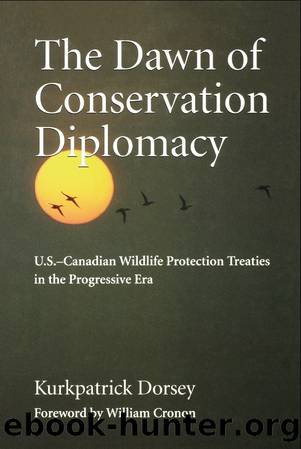The Dawn of Conservation Diplomacy by Kurkpatrick Dorsey

Author:Kurkpatrick Dorsey [Dorsey, Kurkpatrick]
Language: eng
Format: epub
Tags: History, United States, 20th Century, Technology & Engineering, Agriculture, Forestry
ISBN: 9780295989792
Google: f3sUCgAAQBAJ
Publisher: University of Washington Press
Published: 2009-11-17T00:32:07+00:00
CONCLUSION
Before seal conservation could be completed, the treaty's enabling legislation had to make its way through the U.S. Congress. As with the fisheries treaty, the Taft administration's scientific advisors found themselves fighting for respect on Capitol Hill. In this case, though, the issue was not the economic impact of the treaty but rather scientific expertise. For several months, Hornaday and Elliott battled the administration and its supporters for influence in Congress. In the end, as one British diplomat commented, Elliott won because he âgave the impression that he knew more about the seals than the other witnesses.â72
It so happened that Congress was already investigating allegations of corruption in the administration of the Pribilof Islands. Elliott and Hornaday had decided that Nagel's different interpretation of the sealing act of 1910 deserved punishment. Under Elliott's spur, the House Committee on Expenditures in the Department of Commerce and Labor had been scrutinizing government agents and their policies on the Pribilofs, looking for evidence that Nagel and his subordinates had violated the act. In particular, Elliott charged that Lembkey had knowingly encouraged the killing of females and yearling males to fulfill his quotas over several years.73
The hearings were so meanspirited that they succeeded only in widening the chasm between Elliott's friends and foes. Outraged by Elliott's power over the committee, Fisheries Commissioner George Bowers accused Elliott of championing ânearly every improper, vicious and pernicious practice possible in the conduct of the fur seal industry.â Elliott struck back in typical fashion with wild charges of perjury and corruption. The hearings reached new depths when the chairman brought in a trained seal from a very popular exhibit in the Fisheries Commission building. Appropriately, âGeorgeâ performed the usual routine of circus tricks, and he also responded to certain names. When he heard âProfessor Elliott,â he barked and waved his flippers. Upon hearing âCommissioner Bowers,â he hid under a chair.74 It must have seemed that Elliott had the endorsement of the animal kingdom.
Into this circus atmosphere, Representative William Sulzer of New York introduced the treaty's enabling legislation on 7 February 1912. The bill authorized the advance payments to Canada and Japan and the method of dividing up the skins agreed to in the treaty. The House passed the bill unscathed after a bruising battle, but in the Senate Hornaday and Elliott were waiting in ambush. Their agent, Senator Gilbert Hitchcock of Nebraska, attached an amendment to the bill that placed a ten-year closed season on land sealing operations.75 The final outcome would be determined in a conference committee.
As Congress considered the Hitchcock amendment, administration scientists struggled to present their own rationale for killing seals. The members of the Fur Seal Advisory Board argued that male seals had to be harvested for the long-term health of the herd. If left alone, the thousands of young males that survived 1912 would be bulls by 1918. The scientists feared that several thousand extra males would lead to havoc and trampled pups on the breeding beaches. Hornaday demolished their credibility in one
Download
This site does not store any files on its server. We only index and link to content provided by other sites. Please contact the content providers to delete copyright contents if any and email us, we'll remove relevant links or contents immediately.
| Africa | Americas |
| Arctic & Antarctica | Asia |
| Australia & Oceania | Europe |
| Middle East | Russia |
| United States | World |
| Ancient Civilizations | Military |
| Historical Study & Educational Resources |
Never by Ken Follett(2873)
The Man Who Died Twice by Richard Osman(2290)
Machine Learning at Scale with H2O by Gregory Keys | David Whiting(2267)
Fairy Tale by Stephen King(2058)
Will by Will Smith(2033)
Rationality by Steven Pinker(1761)
The Dawn of Everything: A New History of Humanity by David Graeber & David Wengrow(1564)
The Dark Hours by Michael Connelly(1562)
Principles for Dealing With the Changing World Order: Why Nations Succeed and Fail by Ray Dalio(1368)
Friends, Lovers, and the Big Terrible Thing by Matthew Perry(1324)
A Short History of War by Jeremy Black(1295)
HBR's 10 Must Reads 2022 by Harvard Business Review(1251)
Go Tell the Bees That I Am Gone by Diana Gabaldon(1231)
Can't Hurt Me: Master Your Mind and Defy the Odds - Clean Edition by David Goggins(1222)
515945210 by Unknown(1205)
Fear No Evil by James Patterson(1106)
443319537 by Unknown(1069)
Works by Richard Wright(1017)
Going There by Katie Couric(988)
